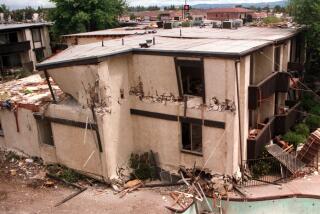A run-for-your-life drill
I lived on the Oregon coast for 10 years, in a small tourist town of 5,000 people. It was built at sea level, on a narrow spit of land a mile and a half wide. Running along the east edge of town was a ridge that represented “higher ground,” which we heard a lot about, as in “run to higher ground immediately!”
It was a wild geophysical area. From certain vantage points you could see Mt. St. Helens 60 miles to the north, with its top blown off. Tectonic plates met a few dozen miles offshore. On any given day, one of those plates could be pushed over or under the other, generating a huge quake and sending a massive wall of water to deluge the coastal communities. A tsunami could arrive in 10 to 15 minutes.
During my first few years of residence, there were frequent earthquakes. I knew I was supposed to “do” something, but I was never sure what. Neither were my neighbors, who’d lived there all their lives. After the Indonesian tsunami, Oregon authorities began intense community training, which was frightening and important but also seemed futile. The more you know, the more you know there is no way to protect yourself fully from the forces that nature can unleash.
A neighbor who served on the city council visited every house on our street. He showed us the maps. In case of a major tsunami, my family’s house, and the whole town, would quickly be under 45 feet of water, moving at high velocity. You couldn’t stay in your house during a tsunami. Even if it could withstand the force of the wave, the second floor or the attic or the roof wouldn’t be safe. You had to flee.
Our instructions were, if we felt an earthquake, to drop everything and immediately run — not drive and not walk — to the foothills on the east edge of town. Can you imagine the terror of this happening in the middle of the night, when your young kids were sound asleep? Can you imagine being elderly or disabled and unable to move quickly?
We began to have community-wide tsunami drills. I participated in four of them. The civil defense siren sounded and the entire town headed for the foothills. My kids were in school, and the school was built on the hillside, so I didn’t have to worry about them. It was just me, trying to flee to safety. I had 10 minutes to get to higher ground, and I timed myself, trying to make it, always hoping I would.
The major problem was that at the base of the hills, there was a river running through the town. In order to climb into the hills, you had to cross the river. But there were only two bridges, which was the reason we were told not to drive. There simply wasn’t space or time to try to get hundreds of cars across those bridges.
You had to pick the closest bridge and head for it, hoping that in a real emergency, the bridge would still be there so that you could get across.
I never made it to the foothills in my allotted time, no matter how fast I left my house or how vehemently I ran. At 10 minutes, I was always still crossing the river bottom, careening toward the bridge but not able to reach it. In a real disaster, I would have been swept away, killed.
The geologic records for the Oregon coast show that the area experiences a major tsunami every 200 years with frightening regularity. By the time I moved away from that dangerous history, the town was 50 years overdue. I didn’t move just because I couldn’t win the tsunami race, but it was a factor.
I came to California. I live inland. And the Big One here? Way overdue.
Cheryl Holt is the author of 27 novels. She lives in Burbank.
More to Read
A cure for the common opinion
Get thought-provoking perspectives with our weekly newsletter.
You may occasionally receive promotional content from the Los Angeles Times.






